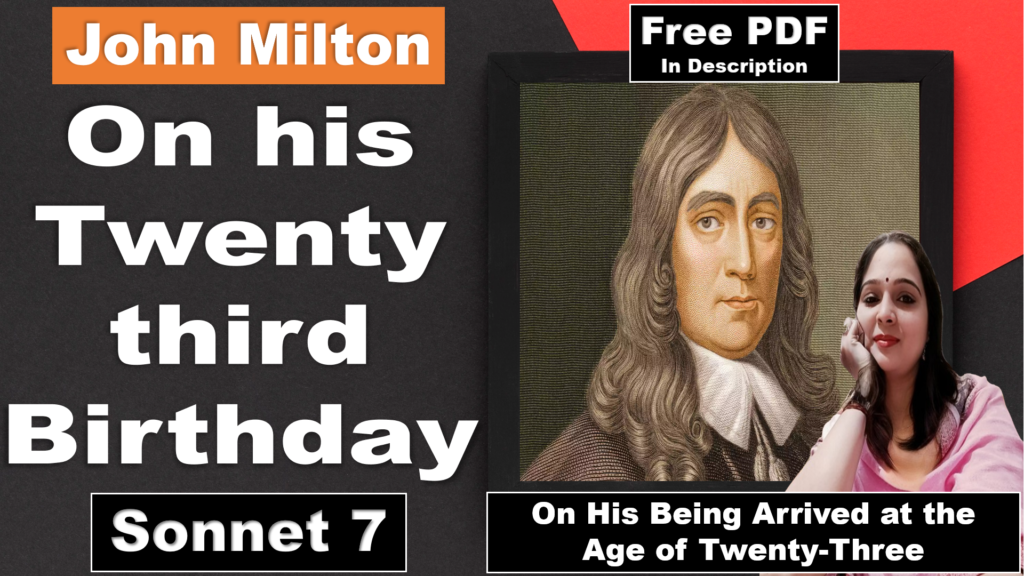
Essay Type Questions
Q. Write the critical appreciation of the poem?
Introduction
The poem On His Having Arrived at the Age of Twenty-three is a devotional sonnet written in an autobiographical tone. It contains Milton’s reflections of late maturing. The dominating passion of his life is to justify the ways of God to man and write in praise of God. Here, he blames Time for stealing away his youth without repairing his poetic talent .He uses the sonnet form of poetry to produce a personal utterance that combines dignity of lone, flexibility of movement and mastery of structure.
Themes
The passage of time and mortality: The speaker is acutely aware of the passage of time and his own mortality. He laments the fact that he is growing older and that he has not yet achieved the maturity and success that he feels he should have. This theme is evident in the first four lines of the poem:
How soon hath Time, the subtle thief of youth,
Stol’n on his wing my three-and-twentieth year!
My hasting days fly on with full career,
But my late spring no bud or blossom shew’th.
Faith in God: The speaker’s faith in God is central to the poem. He knows that he is accountable to God for his life, and he is committed to living in a way that pleases God. This is evident in the final couplet of the poem:
All is, if I have grace to use it so
As ever in my great Task-Master’s eye.
Structure and Form
“On His Being Arrived at the Age of Twenty-Three” is a traditional Italian sonnet, consisting of 14 lines in iambic pentameter with a rhyme scheme of ABBAABBA CDECDE. This structure gives the poem a sense of order and balance, which is appropriate for the poem’s themes of faith and acceptance.
Poetic Devices
Milton uses a variety of poetic devices in “On His Twenty third Birthday,” including:
Metaphor: Milton compares time to a “subtle thief” in the first line of the poem. This metaphor suggests that time is fleeting and that it can easily steal away our youth and our lives.
Personification: Milton personifies time in the first line of the poem by giving it wings. This makes time seem more real and threatening.
Enjambment: Milton uses enjambment throughout the poem to create a sense of flow and movement. This is particularly effective in the first four lines of the poem, where the speaker describes the rapid passage of time.
Caesura: Milton uses caesura throughout the poem to create pauses and emphasis. This is particularly effective in the final couplet of the poem, where the speaker emphasizes his commitment to living a life that pleases God.
Conclusion
“On His Twenty third Birthday” is a beautifully crafted sonnet that explores the themes of the passage of time, mortality, and faith. The poem is both personal and universal, and it continues to resonate with readers today.
Q. Briefly describe Milton’s feelings on his having arrived at the age of twenty-three.
Answer: On His Having Arrived at the age of Twenty-three is poet’s reflections on his late maturing. He has attained the age of twenty-three. He takes it as a loss of his life. He feels that it has approached in such a manner that he could not notice it. The prime of his life is lost. He couldn’t mind his career. He couldn’t achieve the height of the poetic talent. He feels being cheated or deceived by the time which has taken away his ripening period without notice. The poet is not at all happy but one thing gives him relief is that it was the will of God.
Q. Analyse the poem as a Petrarchan Sonnet.
Answer: Sonnet is a short poem of fourteen lines expressing a single thought or emotion at a time. It owes its popularisation to the 14th century Italian poet Franesco Petrarch who used this poetic form to express his love for his idealised lady love, laura. John Milton uses the original Italian (Petrarchan) form to express his devotion to God or sublime feelings.
In this form, the poem Is divided into two parts the octave (a stanza of eight lines) and the sestet (a stanza of six lines). The first part makes a statement or puts up a question while the second part illustrates or serves the answer to it. On Being Arrived at the Age of Twenty-three is a devotional sonnet in Petrarchan form. It is a striking example of the Renaissance ethos and Reformation zeal. It is an assertion of faith and a wish to be guided by the divine will.





